The 2016 First Year Player Draft is less than a month away with round one getting underway on Thursday June 9th and the fortieth round wrapping up on Saturday, June 11th. The draft – alternately referred to as the June Draft, Amateur Draft or Rule 4 Draft – will be streamed from MLB Network’s studios in Secaucus, New Jersey. The Philadelphia Phillies will pick first overall for the second time in their history.
This is the 51st year of the draft that was instituted in 1965 to attempt to seek a more competitive balance among major league baseball teams. Although the Dodgers have never been awarded a first overall selection, Dodger fans will remember that play-by-play announcer Rick Monday was the first player to ever have his name called in the inaugural draft. The Dodgers have selected players who later became first overall selections but chose not to sign at the time they were picked by the Dodgers – David Price (2004) and Luke Hochevar (2002 and 2005).
Dodger fans may also recall that the 1968 draft by the Dodgers is largely considered to be by far the most productive team draft ever. In all 15 players selected in that draft by the Dodgers made it to majors. Nine of them played for the Dodgers – Davey Lopes, Geoff Zahn, Bobby Valentine, Bill Buckner, Tom Paciorek, Joe Ferguson, Doyle Alexander, Steve Garver, Ron Cey.
Al Campanis, the Dodgers General manager in 1968, wanted to improve his approach on the draft so he turned to football that has had an entry draft since 1936. He consulted with Los Angeles Rams owner Dan Reeves and San Diego Chargers coach Sid Gillman. Gillman directed Campanis to Chargers director of player personnel Al LoCasale who had a profound influence on Campanis.
“He actually showed me how to draft,” Campanis told MLB.com’s Ken Gurnick in a 1988 story for Baseball America. “He explained the difference between drafting the best athlete or going for need. He showed us how to rank players on a scale of 100 based on fundamental skills. He took a neophyte and taught me how to approach a draft, and I think this helped us.”
In April of 1987 Campanis’ tenure with the Dodgers came to an end – and coincidence or not – the Dodgers have not made a World Series appearance since 1988.
This year the Dodgers have four of the first 65 selections. Along with their number 20 and number 65 picks they have a number 32 selection as compensation for Zack Greinke who signed with the Arizona Diamondbacks. A fourth selection – number 36 – comes as compensation for not being able to sign pitcher Kyle Funkhouser whom they had drafted in the 35th round of last year’s draft. Speculation is that Funkhouser may not have improved his draft prospects as his 2016 campaign with the University of Louisville Cardinals features a 4.54 ERA along with a 1.44 WHIP and 40 walks in 70 innings.
The 2016 drafting class has been described as soft even compared to the class of 2015. There is no one player that is considered a given as the first overall selection. There is no Stephen Strasburg, Bryce Harper, Carlos Correa, Kris Bryant or Clayton Kershaw. However, that does not mean that teams still cannot have a strong draft relative to the competition.
The top overall selection among the many mock drafts for 2016 is still very much in a state of flux with pitchers Jason Groome, A.J. Puk and Riley Pint garnering much of the attention but recently being challenged by outfielders Kyle Lewis and Corey Ray as well as third baseman Nick Senzel.
“I think it’s the most uncertain top five in recent memory,” one scouting executive said.
Let the speculation begin. What will be the Dodgers drafting strategy? Will it follow last’s year scenario, the first with President of Baseball Operations Andrew Friedman at the helm? Will necessity cause a new plan to be followed? In January former Blue Jays General Manager Alex Anthopoulos was hired by the Dodgers as Vice-president of Baseball Operations. Will his success at ferreting out quality young arms for the Blue Jays come into play with the Dodgers 2016 draft selections?
I expect it is pretty much a certainty that the truth will not be known until the draft has been completed and even then a drafting pattern may not emerge. Maybe it boils down to expediency or the luck of the draft. There are a number of ways to go heading into the draft. How long a plan can be followed is almost totally dependent on what the other 29 teams do with their preferred selections.
Jeff Ellis of “Scouting Baseball” perhaps sets the stage for the Dodgers’ drafting plan:” When I look at what Dodgers President Andrew Friedman did in the draft last year and the past few years with the Rays, it is clear that he has a very conservative drafting approach.”
- Although Friedman may be conservative in his approach, will circumstances dictate a deviation from that plan and force him to turn early – seemingly not his preferred choice – to high school players, more specifically to high school pitchers?
“The strength of this draft is high school pitchers,” a National League scouting director said. “There are a whole lot of general managers who don’t want to take high school pitchers early, but you have to adjust to the talent that’s out there. The guys who are better at the Draft are the guys who know that.”
Certainly some viable options with the 20th pick may well be: Joshua Lowe (3B), Kevin Gowdy (RHP), Reggie Lawson (RHP), Alex Kirilloff (OF), Carter Kieboom (3B), Braxton Garrett (LHP), Matt Manning (RHP).
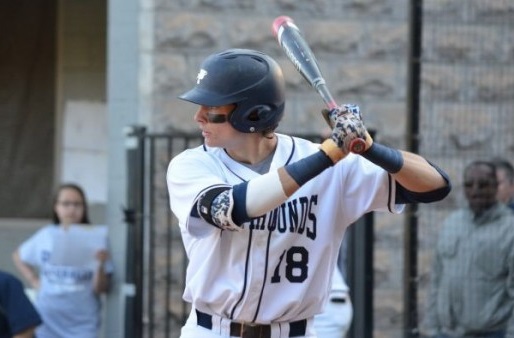
Joshua Lowe
(Photo courtesy of popeathletics.com)
- Will the Dodgers follow their 2015 plan in which they took pitchers Walter Buehler and Kyle Funkhouser with their first two selections most likely knowing Buehler would require Tommy John surgery and Funkhouser was thought to be a steal but signability might be an issue, which it was? It seems Andrew Friedman has an eye for players who have fallen out of top-10 selection territory.
Two definite possibilities for the Dodgers in June would be Stanford’s Cal Quantrill and Oregon’s Mark Krook both of whom have had Tommy John surgery and fallen in the draft as a result of their surgeries, perhaps out of the top-10. Quantrill, the son of Paul Quantrill who spent the 2002 and 2003 seasons with the Dodgers, had his surgery in March of 2015. Krook returned to action in 2016 after his Tommy John surgery in 2014.
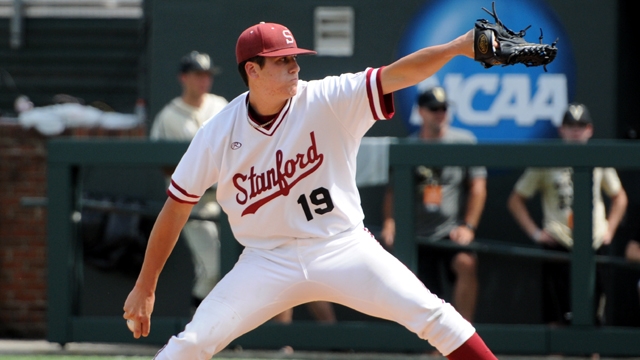
Cal Quantrill
(Photo credit – Andrew Prezioso)
- Will the Dodgers look more specifically to position players who may tumble into their laps? Prep players Joshua Lowe and Nolan Jones, both third basemen, may well be available with the 20th pick. Another choice that most likely might be taken without much hesitation would be outfielder Nick Banks if still available that late in round one.
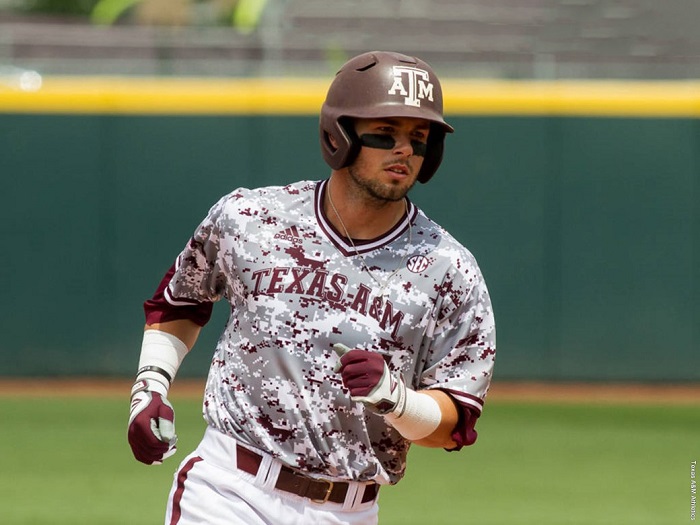
Nick Banks
(Photo courtesy of 12thman.com)
- With their first selection will the Dodgers be looking for projectabilty? That is, a player with a good frame that has not yet filled out meaning the player has an untapped ability to grow, mature and improve. It can be a skinny pitcher with a very fast arm. It can be a great swing from someone who will fill out and become stronger. It can be many things that could cause a scout to think a player is projectable. It requires looking ahead a couple of years trying to determine what his ceiling might be.
Taylor Ward of “Baseball Scouting” suggests the Dodgers have built their farm system predicated on safe, projectable picks: “The Dodgers have one of the top farm systems in baseball and they take projectable players who are also safety picks. Jefferies is another case for one of the best pitchers in the nation who could be an undervalued arm. The Dodgers can save some bonus money here and use the rest with their pick that is 12 selections away.”
The Jefferies to whom Ward refers is 6’0” -180 lb Daulton Jefferies out of California University. Although not comparing Jefferies to Sonny Gray, MLB.Com makes a case for smaller players that also may be projectable: “While many teams prefer their pitchers big, tall and projectable, sometimes they come in different sizes. The success of starters like Sonny Gray in the big leagues will undoubtedly give teams more confidence to take a closer look at Jefferies.”
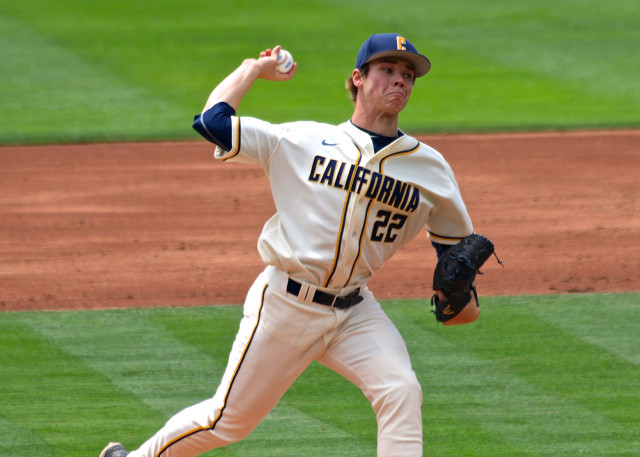
Daulton Jefferies
(Photo credit – Shotgun Spratling)
- Logic would dictate that the Dodgers will select the best player available with the first round selection and all successive picks. They have a draft bonus pool of $9,273,900 which is not insignificant but still must be managed in a judicious manner. The slot value of their first pick (20) is $2,315,800 while the two compensation picks (32 and 36) have a slot value of $1,940,700 and $1,791,000 respectively.
While it’s certainly possible to simply take the best players on the board and sign them for close to the slot value, the Dodgers are among the organizations that will have some elbow room with the bonus pool to pursue creative combinations of players. It also means that they must have a relatively good idea if the best players available that they are pursuing early will sign.
The best player still on the board with their twentieth selection might be a Jordan Sheffield, a right-handed pitcher out of Vanderbilt. Perhaps Dakota Hudson out of Mississippi State, also a right-handed pitcher, is still available when the Dodgers make their first pick.
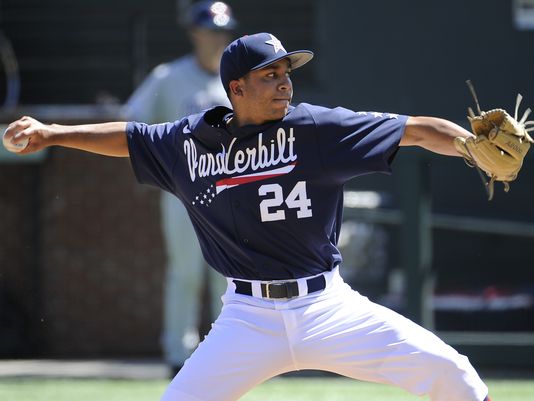
Jordan Sheffield
(Photo credit – Shelley Mays)
In any event, buckle up and enjoy the ride beginning on June 9th.




 May 14th, 2016 at 6:00 am
May 14th, 2016 at 6:00 am  by Harold Uhlman
by Harold Uhlman  Posted in
Posted in 

You didn’t mention Chase Utley, drafted after high school but went to UCLA. And Tom Seaver. They seem to have done all right last year by taking more college players, but with a lot of prospects in the higher minors, taking a chance on high-school players might be the way to go.
Are you surprised they didn’t promote Tim Locastro to take Maggi’s place at Tulsa?
Yes I am surprised that Locastro hasn’t been promoted to the Drillers but hang onto your hat. Drew Maggi has been assigned to the OKC Dodgers. He played SS for the Dodgers last night.
Also surprised that Kyle Garlick and Scott Griggs have not been promoted to Tulsa from RC.
Hadn’t thought of Utley – a great example. Seaver’s was back in the sixties and most unusual that he wound up with the Mets. The Dodgers could have entered the lottery for him and had a one in four chance of signing him.
Harold, great article. Four out of the first 65 picks! Will be interesting how FAZ approaches this draft. With the dollars you stated above, $9,273,900 total draft pool, $7,988,200 draft pool for the four top picks doesn’t leave much money for the rest of the draft (If I understand how it works).
I wonder if Dodgers would intentionally draft a player (or two) in supplemental draft round with signability issues. Draft pick would rollover to 2017 and give Dodgers more money for later draft picks this year (Again, if I understand how it works). Might tie in with Snider Fan’s observation above, about farm system already being stacked.
I am looking forward to seeing where Funkhouser goes this year.
I would be misleading you if I indicated I know exactly how it works or what the combinations and permutations are. Last year Funkhouser (Boros) took them pretty well up to the last possible signing day. If you do not sign a player, you lose the slot money associated with that pick. It can’t be redirected.
What you say certainly sounds plausible. I think it might depend on what players are available with those high picks. Three out of four might be creative. Also this is not considered to be a strong draft year so maybe you just have to take whomever you can when you can.
However, I think that is why a Cal Quantrill might be a target. That is, formerly ranked much higher, with perhaps the same potential, but now most likely available for under slot value. Senior college players have really no leverage so may be the ones that sign for under slot value especially if they have fallen somewhat in their ranking.
I really haven’t look at the penalty for signing over the bonus pool allotment but expect the Dodgers would definitely not go over far enough to lose a #1 draft pick in 2017.
Harold, thanks for the clarification regarding not reallocating slot money if player not signed.
Do you know if $1,285,700 is the normal amount of slot money for all the other draft picks or have Dodgers been penalized, in slot money, for doing something?
The Dodgers have not been penalized. There are some slight discrepancies in slot values for the Dodgers with different sources but they are slight.
Dodgers 2016 MLB Draft bonus pool
Round Pick Slot value*
1 20 $2,315,800
Supp, 32 $1,940,400
Funk. 36 $1,790,700
2 65 $993,600
3 101 $596,500
4 131 $442,300
5 161 $331,000
6 191 $247,900
7 221 $187,300
8 251 $175,100
9 281 $163,400
10 311 $156,600
Totals $9,340,600
First Round Bonus Pool Slot Values
1. Phillies: $9,015,000
2. Reds: $7,762,900
3. Braves: $6,510,800
4. Rockies: $5,258,700
5. Brewers: $4,382,200
6. Athletics: $4,069,200
7. Marlins: $3,756,300
8. Padres: $3,630,900
9. Tigers: $3,505,800
10. White Sox: $3,380,600
11. Mariners: $3,286,700
12. Red Sox: $3,192,800
13. Rays: $3,098,900
14. Indians: $2,973,700
15. Twins: $2,817,100
16. Angels: $2,660,800
17. Astros: $2,504,200
18. Yankees: $2,441,600
19. Mets: $2,378,800
20. Dodgers: $2,316,300
21. Blue Jays: $2,285,100
22. Pirates: $2,253,700
23. Cardinals: $2,222,500
24. Padres: $2,191,200
25. Padres: $2,159,900
26. White Sox: $2,128,500
27. Orioles: $2,097,200
28. Nationals: $2,065,900
29. Nationals: $2,034,600
30. Rangers: $2,003,400
31. Mets: $1,972,100
32. Dodgers: $1,940,700
33. Cardinals: $1,909,500
34. Cardinals: $1,878,000
Supplemental First Round
35. Reds: $1,837,200
36. Dodgers: $1,791,000
37. Athletics: $1,745,700
Go through the list of Dodgers pitching prospects who may be ready within the next two to three seasons and with a draft that is strong in high school pitchers I will not be surprised that Dodgers target this position throughout the draft, especially LH pitchers. Unless someone falls in the draft because of injury and/or sign-abililty issues, 6′ 5″ high school LH’er Joey Wentz looks like a possible selection at 20. No. 32 — high school RH’er Jared Horn who is an athletic, aggressive pitcher who regularly hits 96 mph. No. 36 — high school athletic RH’er Alex Speas who has hit 97 mph this year, but inconsistent. 65 — Dodgers would be very lucky if high school SS/3b Carter Kieboom falls that low, but a Clemson commit might scare some teams off. If not Kieboom, then high school 3b Bo Bichette, son of Dante.
Great picks SCB. I doubt they will go with four high school players with the first four picks but those are interesting options. They are less apt to sign so the Dodgers have to have some assurance of signability with those picks. That’s why I think a player like Quantrill who can be signed for under slot might be an early pick to gain some financial flexibilty with high school players to be signed within the first ten rounds. Or, to take a chance on a higher profile HS player later in the draft not drafted because of signability.
Excellent point about the high schoolers. Perhaps Wake Forest third baseman Will Craig at no. 36 as the Dodgers are pretty thin at that position in the minors.
I could see Lowe or Kieboom if still available at 32 or 36 if Quantrill, Jefferies or Krook are signed below slot at 20. However, I doubt they will be available that late.
Craig is interesting and has been a pretty good two-way player.
All good points. Craig could start his Dodgers career at Lo A and go to Hi A before end of Summer. I have a lot of confidence in Dodgers finding gems in the draft. Baseball America does a good job of following the draft and has interesting scouting reports and video of many players (subscription required)
I haven’t subscribed to BA. Probably should.